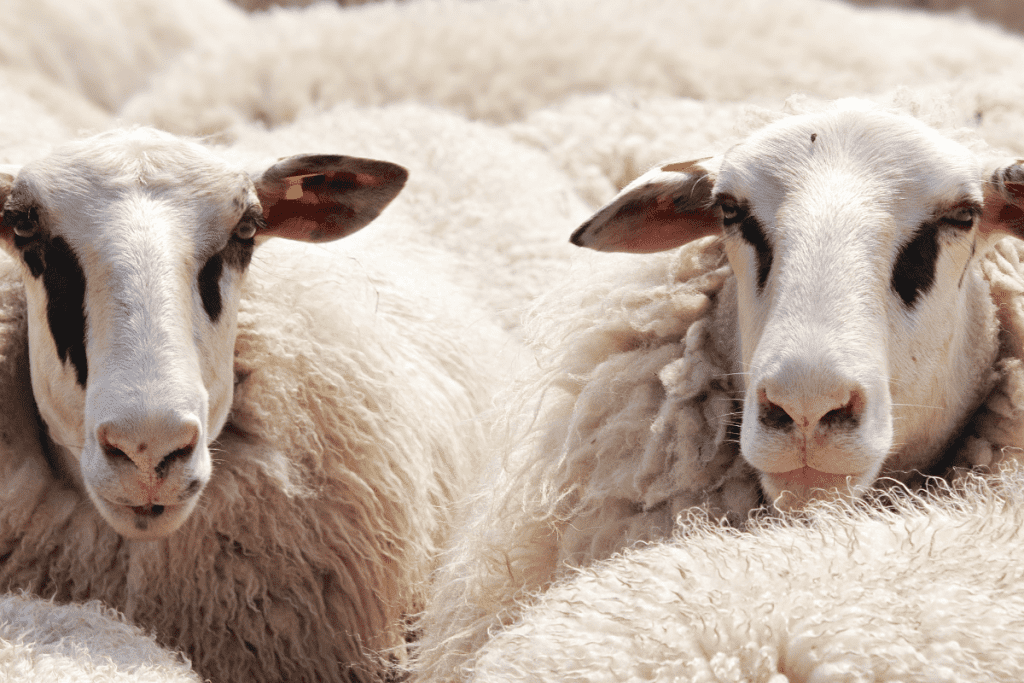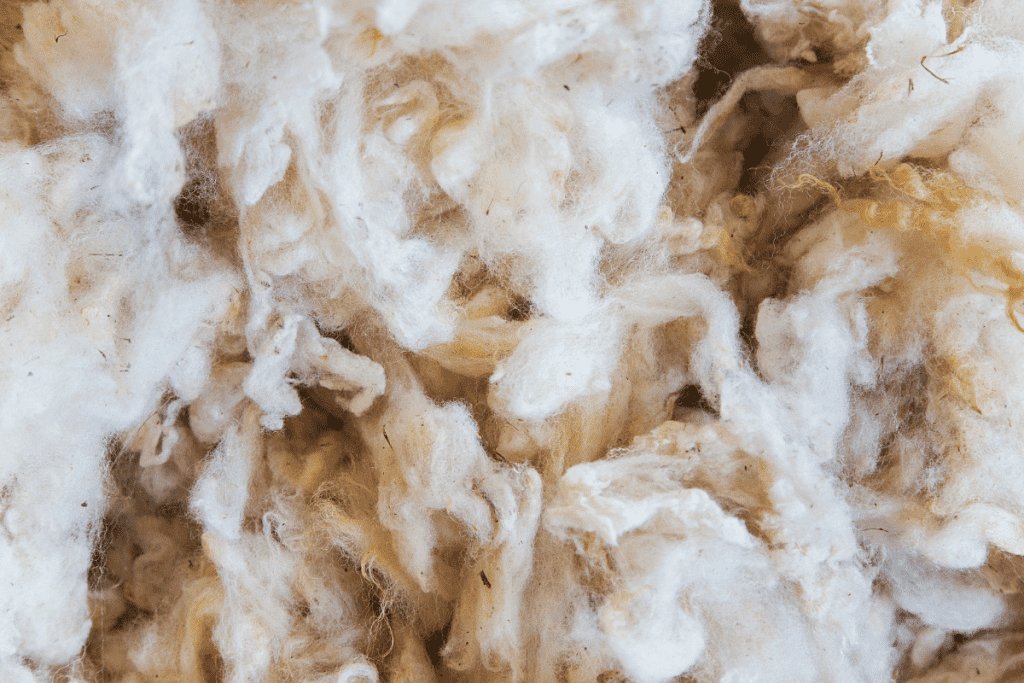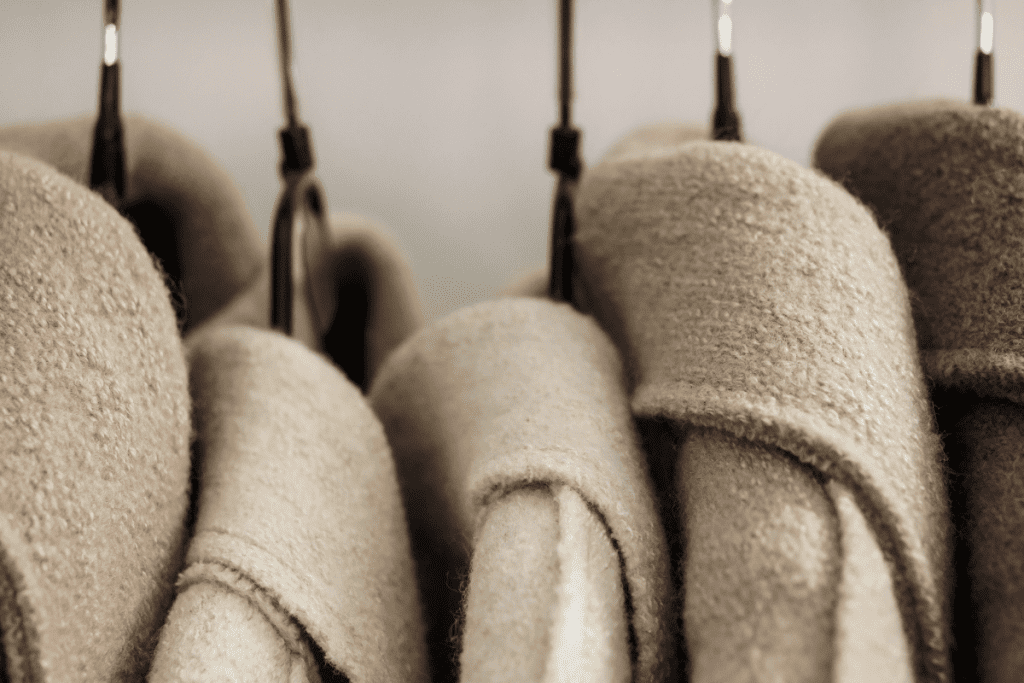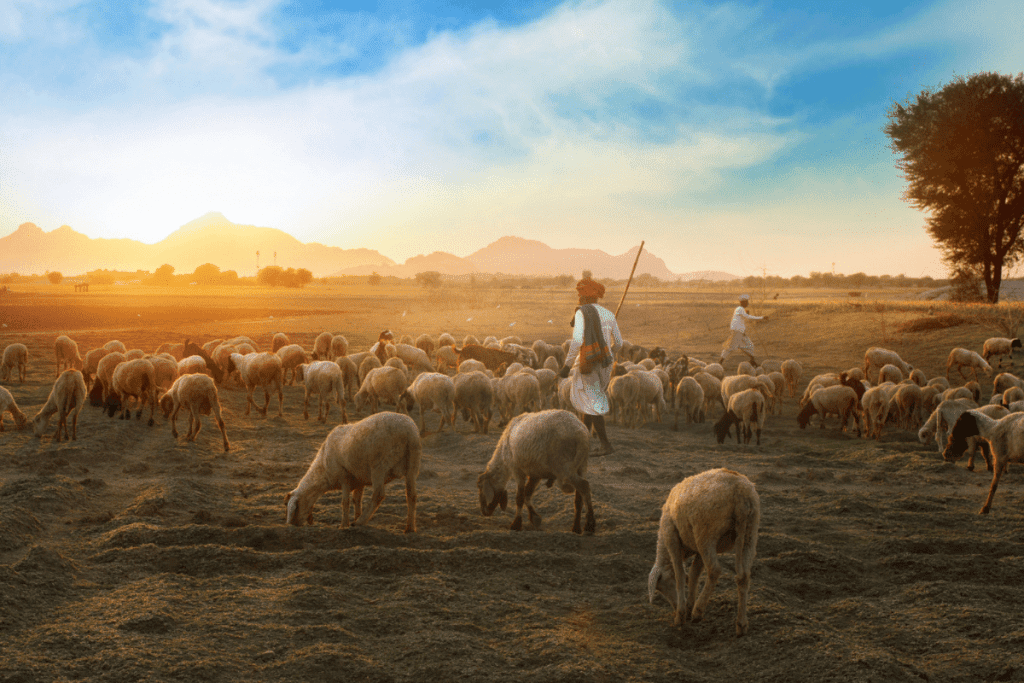If you own sheep or are simply curious about the wool market, you might wonder where to sell sheep wool.
There are various types of wool and multiple ways to sell this wool to make money.
With so many options, we wanted to help you with this guide.
Visit wool buyers from the American Sheep Industry Association to find commercial buyers of wool. To find private buyers of wool, most people list their products on Etsy.com or forums like ravelry.com. It’s also possible to sell wool, raw or processed, nationally or internationally.
If you’re wondering about the best markets for sheep wool, the price of sheep wool, or even how the wool market works, this article will answer your questions!
Read on for tips about marketing your wool, where to sell your wool, and more.

Table of Contents
ToggleWhat Are the Best Markets for Sheep Wool?
There are two basic options for selling wool: commercial or private. Commercial wool sales center around large amounts of wool, most of which are exported overseas. Private wool sales involving smaller amounts are moved directly from individual seller to buyer.
Wool producers with more extensive operations can sell wool into the commercial market, which primarily exports wool to other countries.
Most of the wool produced in the U.S. is exported to other countries via commercial markets.
Smaller wool operations have two options: to sell into a wool pool or to sell directly to individual buyers.
Wool pools collect wool from small wool producers and then sell it in more significant amounts.
Wool auctions are similar, with warehouses combining similar lots of wool and selling it in large amounts later.
When selling to individual buyers, wool producers can use local farmer’s markets, online resources like Etsy.com, and fiber festivals to move their wool.
What Are Some Great Fiber Festivals to Sell Wool At?
There are fiber festivals taking place worldwide, where fiber enthusiasts gather to admire and purchase wool and other fibers.
Here is a list of some of the major fiber festivals worth visiting in your lifetime.
- The Mat-Su Valley Fiber Festival
- The California Wool and Fiber Festival
- The Iowa Sheep and Wool Festival
- The Maryland Sheep and Wool Festival
- The Maine Fiber Frolic
- The Northern Michigan Lamb and Wool Festival
- The New York State Sheep and Wool Festival
- The Vermont Sheep and Wool Festival
- The Wisconsin Sheep and Wool Festival
How Do I Find a Local Farmer’s Market to Sell Wool At?
Use this search engine from the USDA to find your local farmers’ market.
Most farmers’ markets will allow you to set up a table to sell goods for a fee, which is generally quite worth it because the prices are often low, and you get access to a great many buyers by having a table at a farmers’ market.
Many independent wool spinners shop for fiber at farmers’ markets and fiber festivals.
Larger cities often have their networks of farmers’ markets like the Greenmarkets in New York City and the Crescent City Farmers’ Market in New Orleans.
Go to any farmers’ market’s website to find out more about signing up to run a stand to sell your goods.
How Much Does Raw Sheep Wool Sell For?

The price of raw sheep wool depends on the micron measurement of the individual fibers of wool. The finer the wool, the more expensive it is. Average wool prices per pound have ranged from $1.45 to $1.7 in the past six years.
Some wool is worth much more than other wool.
Finer grades of wool with micron diameter measurements of 18-20 sell for much higher prices than coarse wool with larger micron diameter measurements of 34-40.
Additionally, wool sells at variable prices depending on your state.
In some states, like Iowa, it may be as little as $0.25 per pound, and in some, such as Wyoming, it’s as much as $2.60 per pound.
Where To Find the Current Price for Sheep Wool
The USDA Farm Service Agency (FSA) reports the national market price for wool weekly. The repayment rate column of their weekly table is where to find the current price per pound for wool as determined by the FSA. The USDA also produces its wool price tables.
Do your market research if you intend to sell your wool privately, online, or in person.
Go to local farmer’s markets and see what other wool vendors are charging for their wool, or browse Etsy.com to see what wool similar to yours is going for.
Doing your market research allows you to set a reasonable but profitable price for your wool so it will sell but still earn you money.
What Determines Wool Price?
The diameter of wool fiber is a significant factor in determining the price of wool.
This is called the grade of wool and is measured in microns.
High-quality fine wool draws much higher prices than raw fleece or dirty wool because it creates a softer, smoother fabric more suitable for clothing.
The condition of the wool is also a factor in pricing.
Whether the wool has been cleaned and carded will significantly impact how much you charge for it.
The length of the wool fibers also determines value, as longer fibers are easier to spin into yarn.
The final factor in determining wool price is simply the demand for wool.
If many people want to buy wool and few people produce it, the prices will be higher.
Likewise, if there is plenty of wool available but few buyers, the prices will be driven lower.
Where Can You Sell Sheep Wool?
Visit wool buyers from the American Sheep Industry Association to find commercial buyers of wool. To find private buyers of wool, most people list their products on websites like Etsy.com or forums like ravelry.com.
For the average person with a small sheep farm, it will be easiest to sell wool privately via third-party websites or in person at farmer’s markets and fiber festivals like the Fiber Festival of New England or the New York Sheep and Wool Festival.
You will be able to profit more from selling your wool privately than by selling it into wool pools or auctions.
How Do You Market Wool?
Either market your wool commercially by selling it to a wool pool or warehouse pounds of wool at a time or market it privately directly to the consumer in smaller quantities. Many fiber artists worldwide want to buy specialty fleeces and quality wool.
Marketing wool directly to buyers requires building a business plan and brand under which you market your wool.
It also requires you to produce a high-quality product a wool buyer will purchase.
How Do You Make Money Selling Sheep Wool?
The average small sheep farmer will likely find more success marketing wool directly to private buyers than selling it into wool pools or warehouses. There is a higher profit margin with private sales because you get to set your price, and you’re able to market your wool however you want to.
When marketing wool privately, it is essential to include all the details about the quality of wool and take good pictures of your product in the case of online sales.
To sell your wool to private buyers, it is crucial to create a brand for your business wool buyers will recognize.
You’ll need to choose a business name, write a business plan, and create a website.
It’s easy to create your website with tools like WordPress or Wix.
There are many other questions about selling wool, so read on to learn more about the topic.
What is Wool Used For?

Wool is used primarily to make clothing because of its thermoregulation properties. When processed correctly, wool is an incredibly strong fiber, making for very durable clothing. While raw wool is itchy and dirty, it becomes a beautiful textile to make clothing with when processed correctly.
Wool is also an excellent material for firefighters and military personnel uniforms because of its flame-resistant properties.
A recent study by AgResearch found wool performed better than both cotton and synthetic materials when worn as undergarments by firefighters and military personnel.
The study compared the effects of flames and simulated bombs on fresh pigskin and found the skin protected by Merino wool was most similar to the control skin not exposed to damage.
The skin protected by polyester and polypropylene saw much more damage than the skin covered in Merino wool.
Wool is also used to make carpeting, pillows, blankets, and it is even used as an environmentally friendly alternative to synthetic insulation.
In addition to the wool itself, lanolin extracted from wool also has many purposes.
Lanolin is applied to the skin to help with eczema or dried-out skin as a lotion.
It is also used to undercoat cars to protect them from rust.
How is Wool Processed?
The beginning of wool processing involves initially removing the wool from the sheep.
This is called shearing, and it takes place at least once a year.
Because sheep wool grows continuously, it must be removed at least annually for the health of the sheep.
After shearing the sheep, the wool is then graded and sorted by its quality.
The quality is determined by the micron diameter of the individual fibers in the wool.
Smaller fibers mean finer wool, while larger fibers mean coarser wool.
The best wool comes from the head, shoulders, and sides of the sheep and makes good clothing.
The wool coming from the underbelly and lower legs is lower quality and is mostly used to make rugs or blankets.
After grading and sorting, the raw wool is then cleaned with various products to remove dirt, vegetable matter, sweat, and grease.
Before the raw wool is cleaned, the weight of these foreign matters makes up 30-70% of the wool’s total weight.
Once all the contaminants are removed from the wool, it is then carded.
Carding is a process by which the wool fibers are straightened and stuck together using a machine with metal teeth that combs the wool.
There are large industrial carding machines and small carding paddles an individual can use to card wool.
Carding prepares the wool for spinning and makes it much more valuable than raw wool.
Most wool buyers want to buy wool already processed up to this point.
The next step in processing a batch of wool is to spin the wool into yarn.
Spinning is a process by which the wool fibers are twisted or spun into strands of yarn.
Lower-quality wool makes scratchy, hairy yarn, while higher-quality wool makes smooth and soft yarn, raising its average price to be higher.
After spinning, yarn may be woven, knitted, or crocheted into clothing and blankets.
The wool may be dyed to create the desired color at any point in the process.
What Sheep Breeds are Best for Producing Wool?
Merino sheep are excellent breeds for wool production.
Merino sheep tend to produce wool with a very small micron diameter, meaning the wool will be very fine.
This increases the value of the wool, meaning you’re able to sell it for more money.
Some Merino sheep breeds include the Booroola Merino, the Delaine-Merino, and the Peppin Merino.
Other sheep breeds exceptional for wool production include Rambouillet sheep, Panama sheep, and Blue-Faced Leicester sheep.
A large part of growing high-quality wool is simply selecting the proper animals to produce your wool.
How Do I Produce High-Quality Wool Buyers Will Want?
One of the most important things in producing high-quality wool is simply keeping your sheep healthy.
Unhealthy, malnourished sheep often have breakages in their fleeces, making the wool much lower quality than healthy sheep.
When fibers in a fleece break, it lowers the fleece value because the fiber length is shortened.
Similarly, your sheep must be sheared properly to maintain the value of the fleece.
If an inexperienced shearer shears your sheep, they may not get close enough to the skin on the first try.
Processing the fleece properly is also essential to maintaining its value.
Additionally, choosing sheep breeds producing finer wool will add value to your fleeces.
Finally, white wool is the most valuable color because it is dyed to become any color the buyer wants.
Is Raising Sheep for Wool Profitable?

Raising sheep solely for wool is sometimes problematic because wool prices are often low, and the labor time involved in processing wool is high. However, if you have enough sheep to produce enough wool and learn to process the wool yourself, it will make some money.
Consider raising some of your sheep for wool and some for meat, increasing the overall profitability of your farm.
Additionally, sheep’s milk is often used to make specialty cheeses, so this is another way to increase the profitability of your sheep farm.
The most important thing to consider when thinking about the profitability of your farm is simply your marketing and outreach.
Can You Raise Sheep for Both Meat and Wool?
Because sheep are generally sheared only once a year, and young lamb meat is the most valuable form of sheep meat, it’s a challenge to market your sheep for both wool and meat.
However, it is possible.
For example, keep several female sheep and mate them every year to sell the lambs for meat while also harvesting wool from the adult females every year or twice a year.
Also, collect milk from your female sheep to make cheeses, which helps you expand your product list.
Is it Safe for Sheep to Take their Wool?
It is completely safe for the sheep as long as shearing is done properly. In fact, it is essential modern sheep are sheared at least once per year, as they have evolved not to shed their coats.
If they are not sheared, their wool gets longer and longer until they are almost unable to move and begin overheating because their body is too well insulated.
Of course, there are risks when shearing sheep.
If an inexperienced shearer is doing the work, they may nick the sheep with the shears and cause bleeding.
Or, in the case of larger unethical sheep operations, the sheep may be treated poorly and mishandled during shearing.
Because shearers in larger operations are paid by the sheep and not the hour, they often hurry the process and are reckless with the sheep.
But overall, if shearing is done properly, it is essential for the sheep’s health.
Why Don’t Sheep Shed?
Some breeds of wild sheep can still shed their wool by scratching themselves on trees and rocks.
However, most domesticated sheep have been bred by humans to produce the excess wool we prize.
Like breeding dogs to bring out specific traits, sheep were bred to highlight genes for excess wool production.
This has resulted in domestic sheep breeds being unable to shed their wool and require shearing at least once annually to keep them healthy.
How Do I Start a Wool Business?
The first step in starting a wool business is doing your research and making sure it is financially feasible.
Sheep are expensive to buy and raise, and you’ll need money to cover your start-up costs.
Lambs can cost up to $150, and the total operating cost per ewe per year may be up to almost $1,000.
Additionally, the median income for farm managers is only about $67,950, which is not much when you consider the costs of running a farm.
Another important part of starting a wool business is to decide whether any of your animals will be used for meat or milk production.
Including meat and milk production in your farm’s overall yield typically makes it much more profitable.
Raise lambs for meat while also harvesting wool and milk from your breeding ewes.
Possibly the most important part of starting a wool business is branding and creating an online presence for your farm so potential buyers of your products can find and connect with you.
Use Facebook, Twitter, Etsy, and Ravelry to connect with other sheep farmers and customers interested in your products.
How useful was this post?
Click on a star to rate it!
We are sorry that this post was not useful for you!
Let us improve this post!
Tell us how we can improve this post?
